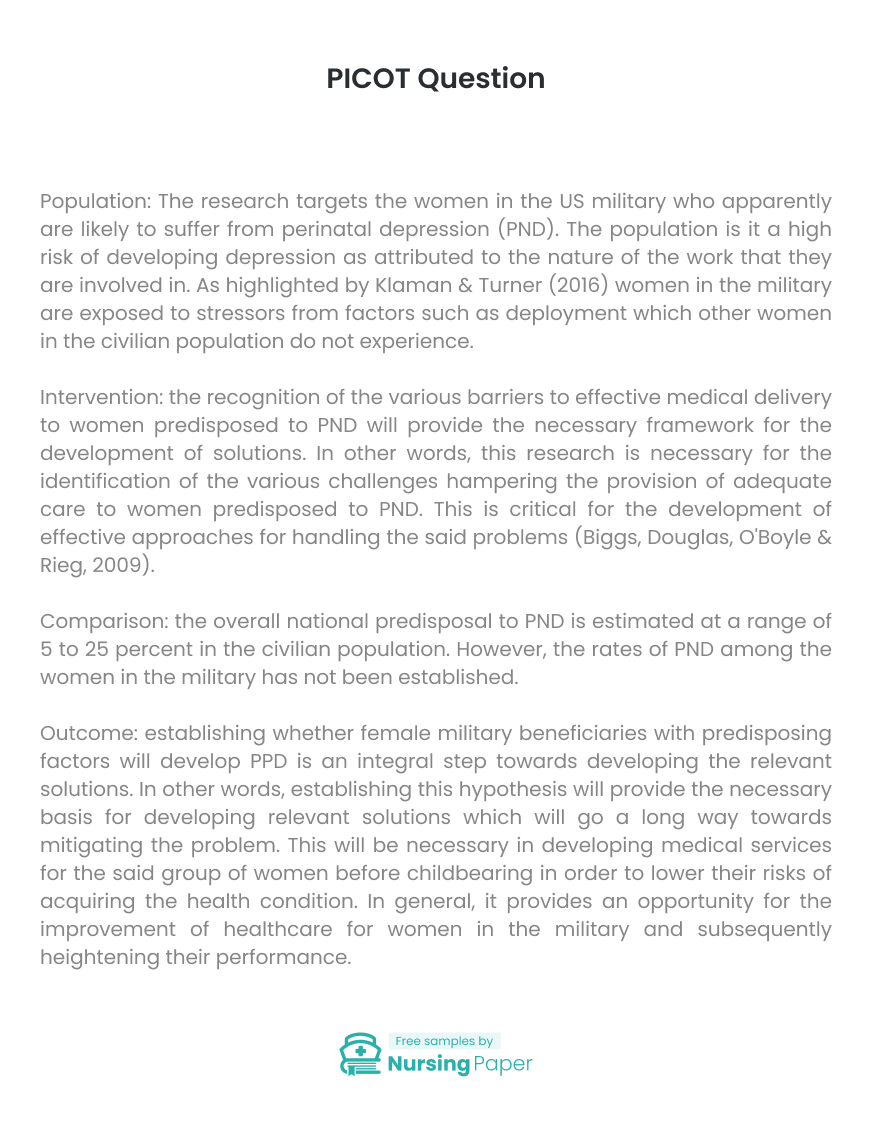
PICOT Question
Population
The research targets the women in the US military who apparently are likely to suffer from perinatal depression (PND). The population is it a high risk of developing depression as attributed to the nature of the work that they are involved in. As highlighted by Klaman & Turner (2016) women in the military are exposed to stressors from factors such as deployment which other women in the civilian population do not experience.
Intervention
The recognition of the various barriers to effective medical delivery to women predisposed to PND will provide the necessary framework for the development of solutions. In other words, this research is necessary for the identification of the various challenges hampering the provision of adequate care to women predisposed to PND. This is critical for the development of effective approaches for handling the said problems (Biggs, Douglas, O’Boyle & Rieg, 2009).


Comparison
The overall national predisposal to PND is estimated at a range of 5 to 25 percent in the civilian population. However, the rates of PND among the women in the military has not been established.
Outcome
Establishing whether female military beneficiaries with predisposing factors will develop PPD is an integral step towards developing the relevant solutions. In other words, establishing this hypothesis will provide the necessary basis for developing relevant solutions which will go a long way towards mitigating the problem. This will be necessary in developing medical services for the said group of women before childbearing in order to lower their risks of acquiring the health condition. In general, it provides an opportunity for the improvement of healthcare for women in the military and subsequently heightening their performance. As indicated by Klaman & Turner (2016) military women are exposed to stressors attributed to deployment which makes it necessary that they are provided with the highest possible health care.
Time
The women are often at risk of developing postpartum depression (PPD) up to 18 months from childbirth.

Picot question: Are female military beneficiaries who have predisposing factors related to military life compared with civilian women at increased risk of postpartum depression (PPD) over 18 months after childbirth.
1. Klaman, S. L., & Turner, K. (2016). Prevalence of Perinatal Depression in the Military: A Systematic Review of the Literature. Maternal and Child Health Journal, 20(S1), 52-65.
2. Biggs, R. L., Douglas, B. H., O’Boyle, A. L., & Rieg, T. S. (2009). The impact of pregnancy on the individual and military organization: A postpartum active duty survey. Mil Med, 174(1), 61-75.



The download will start shortly.

The download will start shortly.
 Subject:
Medicine
Subject:
Medicine  Number of pages: 3
Number of pages: 3  Subject:
Health and Social Care
Subject:
Health and Social Care  Number of pages: 4
Number of pages: 4  Subject:
Nursing
Subject:
Nursing  Subject:
Health and Social Care
Subject:
Health and Social Care  Number of pages: 2
Number of pages: 2  Subject:
Health and Social Care
Subject:
Health and Social Care  Number of pages: 6
Number of pages: 6  Subject:
Nursing
Subject:
Nursing  Number of pages: 4
Number of pages: 4  Subject:
Nursing
Subject:
Nursing  Number of pages: 5
Number of pages: 5  Subject:
Nursing
Subject:
Nursing  Number of pages: 3
Number of pages: 3  Subject:
Nursing
Subject:
Nursing  Number of pages: 17
Number of pages: 17  Subject:
Health and Social Care
Subject:
Health and Social Care  Number of pages: 5
Number of pages: 5  Subject:
Health and Social Care
Subject:
Health and Social Care  Number of pages: 5
Number of pages: 5  Subject:
Medicine
Subject:
Medicine  Number of pages: 2
Number of pages: 2  Subject:
Medicine
Subject:
Medicine  Number of pages: 3
Number of pages: 3  Subject:
Nursing
Subject:
Nursing  Number of pages: 6
Number of pages: 6  Subject:
Health and Social Care
Subject:
Health and Social Care  Number of pages: 2
Number of pages: 2 
